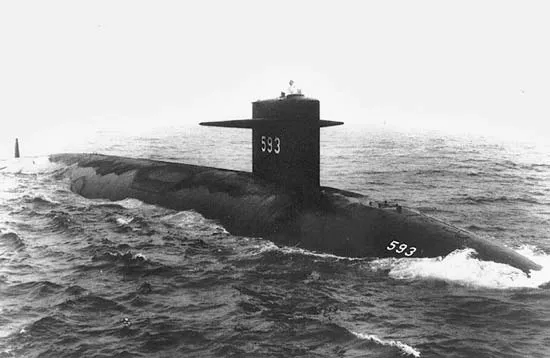On July 9th, 1960, the USS Thresher (SSN-593), the first of a new class of U.S. nuclear-powered attack submarines, was launched. This groundbreaking vessel represented a significant advancement in naval technology and warfare. However, its promise was marred by tragedy when it sank in 1963, resulting in the worst submarine accident in history. The story of the Thresher is one of innovation, ambition, and profound loss, offering valuable lessons for future submarine design and safety protocols.
The Birth of the USS Thresher
The USS Thresher was the lead ship of the Thresher-class submarines, designed to be faster, quieter, and more powerful than its predecessors. The Thresher was built by the Portsmouth Naval Shipyard in Kittery, Maine. It featured a hull made of HY-80 steel, designed to withstand greater depths, and incorporated the latest sonar technology and nuclear propulsion systems, allowing for extended underwater endurance and range.
The Thresher’s design aimed to address the evolving threats of the Cold War era, particularly the increasing capabilities of Soviet submarines. Its nuclear reactor allowed it to operate submerged for prolonged periods without the need for refueling, giving it a strategic advantage in stealth and endurance.
The Launch and Early Service
The Thresher was launched on July 9th, 1960, with great anticipation and pride. Its commissioning on August 3rd, 1961, marked the beginning of a new era in submarine warfare. The submarine underwent rigorous trials and testing to evaluate its capabilities. During these tests, the Thresher demonstrated impressive speed, depth, and maneuverability.
However, the Thresher also experienced numerous technical issues during its initial sea trials. Problems with the reactor coolant system, leaks, and other mechanical failures were noted, leading to several repairs and modifications. Despite these challenges, the Thresher was considered a significant leap forward in submarine technology.
The Fateful Final Voyage
In April 1963, the Thresher embarked on post-overhaul trials after undergoing extensive maintenance and upgrades. On April 9th, the submarine, accompanied by the submarine rescue ship USS Skylark, began deep-diving tests off the coast of Cape Cod, Massachusetts.
During these tests, the Thresher descended to its test depth of approximately 1,000 feet (300 meters). At 9:13 a.m., the USS Skylark received a garbled communication from the Thresher indicating a major problem. Shortly after, all contact with the submarine was lost. Despite immediate search efforts, it became evident that the Thresher had sunk, taking with it all 129 crew members and shipyard personnel aboard.
Investigating the Tragedy
The loss of the Thresher was a devastating blow to the U.S. Navy and the families of those aboard. An extensive investigation was launched to determine the cause of the disaster. The inquiry, led by Admiral Hyman G. Rickover, known as the “Father of the Nuclear Navy,” identified several contributing factors.
The primary cause was determined to be a failure in the submarine’s piping system, leading to flooding in the engine room. The investigation revealed that a leak in a seawater pipe had likely caused the reactor to shut down automatically. Without propulsion, the submarine could not surface. Compounding the issue, the emergency blow system, designed to rapidly expel ballast water and bring the submarine to the surface, failed due to ice forming in the high-pressure air lines.
Lessons Learned and Legacy
The Thresher disaster led to significant changes in submarine design, construction, and operational procedures. The U.S. Navy implemented the SUBSAFE program, an intensive set of design and construction standards aimed at ensuring the safety and integrity of submarines. This program included rigorous testing of all components, enhanced quality control, and stricter maintenance protocols.
The loss of the Thresher also highlighted the importance of effective emergency procedures and crew training. Submarine crews received more comprehensive training in emergency response, and submarines were equipped with improved safety systems to prevent similar catastrophes.
The Impact on Submarine Warfare
The Thresher’s tragic end underscored the inherent risks of submarine operations, especially as they pushed the boundaries of depth and technology. Despite the loss, the advancements made during the Thresher’s development were not in vain. The lessons learned from the Thresher disaster have been instrumental in ensuring the safety and effectiveness of subsequent generations of submarines.
Modern submarines benefit from the rigorous safety standards established in the wake of the Thresher incident. The SUBSAFE program has been credited with preventing further catastrophic losses and has become a model for submarine safety worldwide. The Thresher’s story remains a somber reminder of the perils of undersea warfare and the continuous need for vigilance, innovation, and adherence to safety protocols.
Conclusion
The launch of the USS Thresher on July 9th, 1960, marked a significant milestone in naval history. As the first of a new class of nuclear-powered attack submarines, it promised unprecedented capabilities and strategic advantages. However, the tragic sinking of the Thresher in 1963, resulting in the worst submarine disaster in history, highlighted the critical importance of safety and reliability in submarine design and operations. The lessons learned from this tragedy have had a profound impact on the U.S. Navy and continue to inform the development and operation of submarines around the world.












What do you think?
It is nice to know your opinion. Leave a comment.